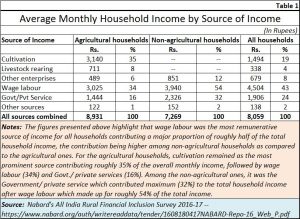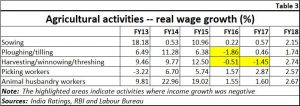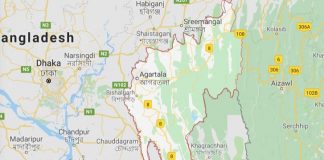https://www.firstpost.com/business/farmers-on-the-war-path-solution-lies-not-in-msp-but-in-giving-farmers-a-share-in-the-revenue-5313951.html
Farmers on the warpath – expected and inevitable
RN Bhaskar – Oct 4, 2018
In many ways, the agitation by farmers around Delhi and Gaziabad was to have been expected. India is moving rapidly towards general elections. Each constituent of India’s vast economy knows that this is the best time to press for its demands. Opposition parties too lie in the wings, waiting to lend support to any movement that brings discredit to the government in power.
A familiar story
This is the game India’s political leaders have taught the masses to play. Laws have remained ineffective to control and penalise vandals. Instead, India’s policy makers have promoted policies that allow for rent-a-mob practices. The free-for-all destruction of life and property is a sad reminder of the callous games politicians are willing to play. They love using humans as cannon fodder, and refuse to penalise the leaders who caused the violence, except when it is politically expedient.
 That is why the Supreme Courts pronouncements on the need to penalise miscreants is long overdue.
That is why the Supreme Courts pronouncements on the need to penalise miscreants is long overdue.
The sad part
But there is a sadder side to the farmer agitation as well. The distress that farmers experience is far greater than most people imagine. They have been exploited by both politicians and the markets for too long. Nothing shows this up better than a Nabard report which was released last month (see chart 1).
Income from cultivation has been pathetically low for farmers. An income of Rs.3,140 per household is barely enough to keep body and soul together. Hence farmers have to augment it through other sources. One source is livestock rearing. But here too, the madness unleashed by irresponsible leaders has caused farmers to become fearful about owning any cattle. True the Supreme Court has forbidden any ban on the slaughter of buffaloes, but the lynchings have scared farmers harribly. It has also affected the beef and the leather industries (http://www.firstpost.com/business/ups-job-woes-cm-yogi-adityanaths-slaughterhouse-ban-could-see-painfull-days-ahead-3347442.html).
It is therefore not surprising that farmers finally decided to go on the warpath. The timing was right, the cause was just and the mass sentiment was with the leaders of the agitation,
 That explains why thousands of farmers tried to enter Delhi as part of ‘Kisan Kranti Padyatra’. True, the police managed to stop them on the outskirts of the capital at the Delhi-Uttar Pradesh border, But that only triggered violence which left some of them injured. It was only in the wee hours of the morning that the agitation was finally called off. The government agreed to double their income and increase the minimum support prices. The demand for arm loan waivers – fortunately – was not accepted.
That explains why thousands of farmers tried to enter Delhi as part of ‘Kisan Kranti Padyatra’. True, the police managed to stop them on the outskirts of the capital at the Delhi-Uttar Pradesh border, But that only triggered violence which left some of them injured. It was only in the wee hours of the morning that the agitation was finally called off. The government agreed to double their income and increase the minimum support prices. The demand for arm loan waivers – fortunately – was not accepted.
But peace could be short-lived. Because the distress farmers face is a lot greater than people think. Just look at some other numbers put out by Nabard. These relate to average farm incomes in each state of this country (see table 2). States where farmers get even lower incomes than the national average include Jharkhand, Bihar, Uttar Pradesh, Madhya Pradesh and Chattisgarh – all of them in North India which is India’s most populous region. And while Madhya Prade4sh and Rajasthan have been able to wrest themselves out of the BIMARU states, the plight of farmers in other states is terribly painful. Clearly, the northern parts of this country – excluding some states like Punjab, Haryana and Himachal Pradesh – have a lot to be sore about. Expect agitations to erupt once again.
Meaningless offerings
But hasn’t the government just agreed to double farm incomes? Shouldn’t the farmers be happy about that? Yes. And no as well.
Any additional money for farm produce is certainly most welcome. But doubling household income from Rs.3,000 to Rs.6,000 cannot be considered a bonanza. In many cases, farmers earn less than Rs.2,000 per month. Raising that to Rs.4,000 isn’t exactly a solution.
There are other problems. Take the soya producers for instance. They would have grown more. But for the past three decades, the government reduced import duties on edible oil. Result: oilseed crushing units lost money. And the farmers got little money for their crop. So for a country that met over 70% of its edible oil requirement through domestic oilseed production. India today depends on imported oil for 90% of its needs.
It is only recently that the government finally decided to marginally increase the import duties on edible oil.
Then there is a policy vacuum when it comes to agriculture. Growing of GM or genetically modified oilseeds are banned in India, but import of edible oil, which has been extracted overseas from GM seeds has been allowed (http://www.asiaconverge.com/2017/09/absurd-posturing-anti-gm-lobby/). There appears to be no clarity on this front as well.
This is what happened with pulses as well two years ago (http://www.firstpost.com/business/importing-pulses-to-maintain-buffer-stock-but-govts-move-at-times-hurt-domestic-producers-3433380.html). Despite the government knowing that the area under pulses cultivation had gone up and a bumper harvest was expected, India’s policymakers allowed import of pulses causing  domestic prices to crash. Result: growers of pulses were up in dire straits. Some committed suicide, some went on the warpath. And the government made clucking noises.
domestic prices to crash. Result: growers of pulses were up in dire straits. Some committed suicide, some went on the warpath. And the government made clucking noises.
Little income growth
And this takes us to another chart by India Ratings, a leading ratings agency (see chart 3). Compare the growth in farm incomes with the package increases India’s legislators awarded themselves, and the irony of the situation becomes clear.
So what is the solution?
The solution lies is moving away from the MS Swaminathan formula of giving farmers 50% more than the cost of farming. It also means abandoning the idea that doubling farm incomes is the best solution.
The first solution runs the risk of bureaucrats craftily calculating permitted costs to arrive at the 50% surplus. That is an exercise that India has seen both in agriculture and in industry (remember the BICP which controlled industrial costs and prices once upon a time?).
The second solution of doubling rfarm incomes is not a solution when farm incomes are under Rs.3,000 per household.
The answer lies in adopting the Verghese Kurien model which ensured that the farmer got a percentage of the market price of his produce (http://www.asiaconverge.com/2018/08/farming-politicians-pricing/). Kurien insisted on giving farmers a minimum of 50% of the market price for milk. He succeeded in giving them 70% and today the Gujarat cooperatives give farmers almost 80% (plus a 5% bonus) of the market price of milk.
Compare this with what farmers get. In Mumbai you will see customers pay 10 times more than the price that is given to the farmer. Obviously the trade does not take 90%. It is agencies controlled by extortionist politicians that take almost 50% of the market price of the produce, leaving the wholesale and retail trade with barely 40% of the price difference. In fact, both together should be getting less than 50% of the market price. Only then will the farmer be able to get integrated w2ith the markets.
But that would mean reducing the easy money available to agencies close to politiciansm ins’t it? That is why they do not like the model Kurien introduced and are loath to extend it to other crops.
Unless the farmer gets a far price for his produce, he will remain exploited. And the weak hit back only when the time favours them – just before elections.
It is a sad cynical cycle India has seen play out again and again and again. Unless some way is found out of it, the farmers will continue to suffer, and middlemen will continue to fatten themselves.











































COMMENTS